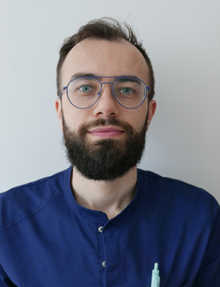Hello to the dynamic ESTRO biology community!
As we prepare for our much-anticipated return to Vienna this May for ESTRO 2025, I am thrilled to invite you to the Predictive Molecular Signatures in Radiation Oncology pre-meeting course on Friday 2 May. This full-day event promises a deep and engaging exploration of how the applications of molecular signatures and prediction models can transform radiotherapy, making treatments more personalised and effective for patients.
I feel extremely fortunate to share the role of course director with two exceptional experts, Conchita Vens from the University of Glasgow and Christopher Talbot from the University of Leicester, both in the UK. Their expertise in radiotherapy genetics and radiobiology has been instrumental in shaping a programme that bridges fundamental science with clinical application. Our shared goal is to create a learning experience that not only informs but also inspires you to apply new concepts in your clinical or research practice.
The course will kick off with an introduction to the basic principles of radiotherapy response prediction. Professor Talbot will set the stage by discussing normal tissue injury prediction, followed by Dr. Vens, who will discuss tumour response and radiotherapy outcome prediction. These opening talks will provide a solid foundation for understanding how predictive models have evolved and what they mean for clinical practice.
The next talk by Jan Bussink from Radboud University Medical Centre, The Netherlands, will offer insights into the historical and contemporary relevance of radiotherapy biomarkers and will highlight the journey from early discoveries to the latest molecular tools. His talk will explore which biomarkers have stood the test of time and why some emerging candidates hold great promise for the future.
The morning session will also feature Nicolaj Andreassen (Aarhus University Hospital, Denmark) and David Azria (ICM Montpellier, France), who will explore molecular and cell-based biomarkers for the prediction of normal tissue injury. Their presentations will not only focus on the scientific principles but also discuss how these biomarkers can be integrated into clinical workflows to enhance treatment planning and reduce side effects.
After the lunch break, we will shift our focus to tumour response prediction. Jacob Scott (Case Western Research University, Cleveland, Ohio, USA), the proponent of the concept of genomic-adjusted radiation dose, will present molecular signatures in radiotherapy response prediction. He will be followed by Heidi Lyng (Oslo University Hospital, Norway), who will share her expertise on the integration of imaging and molecular biomarkers. These sessions promise to provide valuable insights into how the combination of molecular data with advanced imaging techniques can lead to more accurate predictions of treatment outcomes.
The next session will be focused on how we can improve radiation response prediction. The first talk will be delivered by Kristian Unger (LMU University Hospital, Munich, Germany), who will introduce cutting-edge technologies such as multiomics and multiparametric data integration. He will explore how the combination of data from genomics, proteomics and other molecular layers can offer a more comprehensive understanding of tumour biology and response to radiotherapy. After that, Azadeh Abravan (University of Manchester, UK) will present the importance of considering clinical, physical and socioeconomic factors when developing predictive models. She will offer a holistic perspective that emphasises the complexity of personalised therapy.
The final session of the day will focus on moving from theory to practice. Ivan Vogelius (Rigshospitalet, Denmark) will discuss the clinical implementation of predictive models, while Sofia Rivera (Gustave Roussy, France) will provide insights into ways to navigate the challenges of applying these tools in an ever-changing technological environment.
I will have the privilege of concluding the course and summarising the key takeaways as I offer the last talk, which will comprise practical advice on how to integrate predictive models into everyday clinical practice. My aim is to leave participants with clear and actionable strategies that can help to enhance treatment precision and improve patient outcomes.
Beyond the course itself, I encourage you to follow the biology track at ESTRO (which will be marked in yellow in the programme and take place on Saturday and Sunday in the Brahms Room) and approach us at the biology meet-and-greet session (Saturday 3 May at 14.00). These events are fantastic opportunities to connect with peers, share experiences, and explore new collaborations. The ESTRO community thrives on open exchange and collaboration, and I’m confident that this year’s meeting will spark both new ideas and lasting professional connections.
I look forward to seeing many of you in Vienna. Let’s continue to push the boundaries of radiobiology and radiation oncology, always keeping our focus on ways to translate science into tangible benefits for patients.
Warm regards and I’ll see you in Vienna in May!

Bartek Tomasik
Department of Oncology and Radiotherapy, Faculty of Medicine
Medical University of Gdańsk
Gdańsk, Poland
bartlomiej.tomasik@gumed.edu.pl